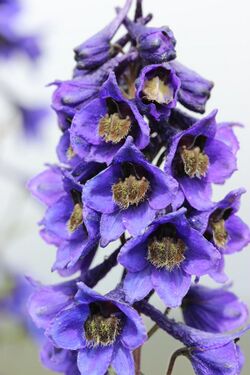Biology:Delphinium elatum
| Delphinium elatum | |
|---|---|

| |
| Scientific classification | |
| Kingdom: | Plantae |
| Clade: | Tracheophytes |
| Clade: | Angiosperms |
| Clade: | Eudicots |
| Order: | Ranunculales |
| Family: | Ranunculaceae |
| Genus: | Delphinium |
| Species: | D. elatum
|
| Binomial name | |
| Delphinium elatum | |
Delphinium elatum is a species of flowering plant in the buttercup family Ranunculaceae, known by the common name alpine delphinium[1] or candle larkspur. It is native to temperate Asia and Europe, it is an erect herbaceous perennial growing to 1.8 m (5.9 ft), with deeply divided leaves. It produces spikes of blue or purple flowers in summer.[2]
Taxonomy
Delphinium elatum was one of the many species described by Carl Linnaeus in his 1753 work Species Plantarum.[3]
Cultivation
It is hardy down to −20 °C (−4 °F), but requires a sheltered position in full sun, and deep, rich soil. All plants must be securely staked to avoid the flower heads collapsing. Gloves should be worn when handling the plant, as it can cause severe discomfort if accidentally ingested.[2]
Delphinium elatum is a source of many ornamental cultivars in a range of colours from blue and purple to pink, cream, and white.[4]
Cultivar series include Magic Fountains,[5] Pacific giant,[6] Dwarf Pacific, New Millennium,[7] and Aurora (six varieties: Blue, Deep Purple, Lavender, Light Blue, Light Purple and White).[8]
The following cultivars have received the Royal Horticultural Society's Award of Garden Merit:
Chemical
Seven C19-norditerpenoid alkaloids can be isolated from Delphinium elatum: N-formyl-4,19-secopacinine, iminoisodelpheline, iminodelpheline, iminopaciline, 6-dehydroeladine, elpacidine, and melpheline.[12]
References
- ↑ (xls) BSBI List 2007, Botanical Society of Britain and Ireland, https://bsbi.org/download/3542/, retrieved 2014-10-17
- ↑ 2.0 2.1 "Delphinium elatum". RHS. https://www.rhs.org.uk/plants/5398/delphinium-elatum/details.
- ↑ Linnaeus C (1753). "Tomus I" (in la). Species Plantarum. 1. Stockholm: Laurentii Salvii. p. 531. https://www.biodiversitylibrary.org/page/358550.
- ↑ "Sunset: Delphinium elatum". http://www.sunset.com/garden/flowers-plants/delphinium-elatum.
- ↑ Royal Horticultural Society
- ↑ Missouri Botanical Garden
- ↑ Dowdeswells Delphiniums
- ↑ Greenhouse Grower
- ↑ "Delphinium elatum 'Lord Butler'". RHS. https://www.rhs.org.uk/Plants/97251/Delphinium-Lord-Butler/Details. Retrieved 5 May 2020.
- ↑ "Delphinium 'Sungleam'". RHS. https://www.rhs.org.uk/Plants/98923/Delphinium-Sungleam/Details. Retrieved 5 May 2020.
- ↑ "Delphinium elatum 'Sweethearts' (New Millennium Series)". RHS. https://www.rhs.org.uk/Plants/256285/Delphinium-elatum-Sweethearts-(New-Millennium-Series)/Details. Retrieved 5 May 2020.
- ↑ Chiba, R; Kanazawa, R; Matsuoka, K; Nakata, A; Tosho, Y; Asakawa, E; Suzuki, M; Ikuta, M et al. (Jul 2014). "Seven C19-norditerpenoid alkaloids from Delphinium elatum". Planta Medica 80 (10): 800. doi:10.1055/s-0034-1382523.
Further reading
Kondo, Toru; Chu, Eiichi; Kageyama, Koji (September 2013). "Stem canker and wilt of delphinium caused by Fusarium oxysporum f. sp delphinii in Japan". Journal of General Plant Pathology 79 (5): 370–373. doi:10.1007/s10327-013-0465-3. http://apps.webofknowledge.com/full_record.do?product=BIOSIS&search_mode=GeneralSearch&qid=13&SID=4CPvY6Z47RkClngHjrH&page=1&doc=3. Retrieved 29 April 2015.
External links
| Wikimedia Commons has media related to Delphinium elatum. |
Wikidata ☰ Q164246 entry
 |

